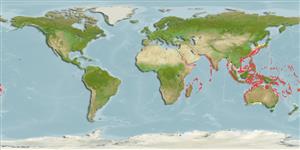Common names from other countries
>
Eupercaria/misc (Various families in series Eupercaria) >
Priacanthidae (Bigeyes or catalufas)
Etymology: Pristigenys: Greek, pristis = saw + Greek, genys, -yos = face (Ref. 45335).
Environment: milieu / climate zone / depth range / distribution range
Ecología
marino asociado a arrecife; rango de profundidad 80 - 100 m (Ref. 4328). Tropical
Distribución
Países | Áreas FAO | Ecosistemas | Ocurrencias, apariciones | Point map | Introducciones | Faunafri
Indo-West Pacific: eastern coast of Africa; north to Japan; south to Indonesia.
Tamaño / Peso / Age
Maturity: Lm ? range ? - ? cm
Max length : 27.4 cm SL macho / no sexado; (Ref. 94109)
Short description
Claves de identificación | Morfología | Morfometría
Espinas dorsales (total) : 10; Radios blandos dorsales (total) : 10 - 12; Espinas anales: 3; Radios blandos anales: 10. Distinguished from its congeners by the following set of characters: D X,11; A III,10; total gill rakers on first arch 23-26, mode 24 (upper limb 6-9, lower 16-18); lateral-line scales 31-37, mode 33; body scales above pectoral fin with about 11-40 spinules on posterior margin, the number increasing with growth up to ca. 20 cm SL; rounded caudal fin in young and adults; colour of posterior soft portions of vertical fins hyaline reddish with black margins, width about 1/4 of pupil diameter in fresh specimens (usually distinct in preservation); 5 white or pale relatively narrow vertical bands on body, the third around 1/4-2/5 width of pupil, somewhat expanded dorsally and ventrally, and relatively vertical throughout, including dorsal and ventral extremities (Ref. 94109).
Life cycle and mating behavior
Maturities | Reproducción | Spawnings | Egg(s) | Fecundities | Larva
Iwatsuki, Y., T. Matsuda, W.C. Starnes, T. Nakabo and T. Yoshino, 2012. A valid priacanthid species, Pristigenys refulgens (Valenciennes 1862), and a redescription of P. niphonia (Cuvier in Cuvier & Valenciennes 1829) in the Indo-West Pacific (Perciformes: Priacanthidae). Zootaxa 3206:41-57. (Ref. 94109)
IUCN Red List Status (Ref. 130435)
CITES (Ref. 128078)
Not Evaluated
Threat to humans
Harmless
Human uses
Herramientas
Special reports
Download XML
Fuentes de Internet
Estimates based on models
Preferred temperature (Ref.
115969): 16.3 - 27.1, mean 23.9 (based on 108 cells).
Phylogenetic diversity index (Ref.
82804): PD
50 = 0.5313 [Uniqueness, from 0.5 = low to 2.0 = high].
Bayesian length-weight: a=0.02239 (0.00929 - 0.05398), b=2.93 (2.73 - 3.13), in cm Total Length, based on LWR estimates for this (Sub)family-body shape (Ref.
93245).
Nivel trófico (Ref.
69278): 3.9 ±0.5 se; based on size and trophs of closest relatives
Resiliencia (Ref.
120179): Alto, población duplicada en un tiempo mínimo inferior a 15 meses (Preliminary K or Fecundity.).
Fishing Vulnerability (Ref.
59153): Low vulnerability (23 of 100).
